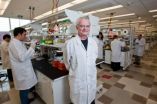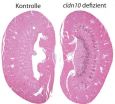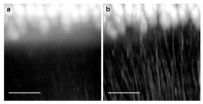(Press-News.org) HOUSTON, Aug. 23, 2012 – Scientists at the University of Houston (UH) have discovered what may possibly be a key ingredient in the fight against Parkinson's disease.
Affecting more than 500,000 people in the U.S., Parkinson's disease is a degenerative disorder of the central nervous system marked by a loss of certain nerve cells in the brain, causing a lack of dopamine. These dopamine-producing neurons are in a section of the midbrain that regulates body control and movement. In a study recently published in the Proceedings of the National Academy of Sciences (PNAS), researchers from the UH Center for Nuclear Receptors and Cell Signaling (CNRCS) demonstrated that the nuclear receptor liver X receptor beta (LXRbeta) may play a role in the prevention and treatment of this progressive neurodegenerative disease.
"LXRbeta performs an important function in the development of the central nervous system, and our work indicates that the presence of LXRbeta promotes the survival of dopaminergic neurons, which are the main source of dopamine in the central nervous system," said CNRCS director and professor Jan-Åke Gustafsson, whose lab discovered LXRbeta in 1995. "The receptor continues to show promise as a potential therapeutic target for this disease, as well as other neurological disorders."
To better understand the relationship between LXRbeta and Parkinson's disease, the team worked with a potent neurotoxin, called MPTP, a contaminant found in street drugs that caused Parkinson's in people who consumed these drugs. In lab settings, MPTP is used in murine models to simulate the disease and to study its pathology and possible treatments.
The researchers found that the absence of LXRbeta increased the harmful effects of MPTP on dopamine-producing neurons. Additionally, they found that using a drug that activates LXRbeta receptors prevented the destructive effects of MPTP and, therefore, may offer protection against the neurodegeneration of the midbrain.
"LXRbeta is not expressed in the dopamine-producing neurons, but instead in the microglia surrounding the neurons," Gustafsson said. "Microglia are the police of the brain, keeping things in order. In Parkinson's disease the microglia are overactive and begin to destroy the healthy neurons in the neighborhood of those neurons damaged by MPTP. LXRbeta calms down the microglia and prevents collateral damage. Thus, we have discovered a novel therapeutic target for treatment of Parkinson's disease."
INFORMATION:
Gustafsson, professor Margaret Warner, research assistant professor Xin-Jie Tan, and postdoctoral fellows Wanfu Wu and Yubing Dai authored the PNAS study, which is available at http://www.pnas.org/content/early/2012/07/18/1210833109.abstract.
About the University of Houston
The University of Houston is a Carnegie-designated Tier One public research university recognized by The Princeton Review as one of the nation's best colleges for undergraduate education. UH serves the globally competitive Houston and Gulf Coast Region by providing world-class faculty, experiential learning and strategic industry partnerships. Located in the nation's fourth-largest city, UH serves more than 39,500 students in the most ethnically and culturally diverse region in the country. For more information about UH, visit http://www.uh.edu/news-events/.
To receive UH science news via e-mail, sign up for UH-SciNews at http://www.uh.edu/news-events/mailing-lists/sciencelistserv/index.php.
For additional news alerts about UH, follow us on Facebook at http://www.facebook.com/UHNewsEvents and Twitter at http://twitter.com/UH_News.
Therapeutic avenues for Parkinson's investigated at UH
Body's own hormone shows promise in protecting dopamine, leading to possible treatments
2012-08-23
ELSE PRESS RELEASES FROM THIS DATE:
Gene 'switch' may explain DiGeorge syndrome severity
2012-08-23
The discovery of a 'switch' that modifies a gene known to be essential for normal heart development could explain variations in the severity of birth defects in children with DiGeorge syndrome.
Researchers from the Walter and Eliza Hall Institute made the discovery while investigating foetal development in an animal model of DiGeorge syndrome. DiGeorge syndrome affects approximately one in 4000 babies.
Dr Anne Voss and Dr Tim Thomas led the study, with colleagues from the institute's Development and Cancer division, published today in the journal Developmental Cell.
Dr ...
New insights into salt transport in the kidney
2012-08-23
Sodium chloride, better known as salt, is vital for the organism, and the kidneys play a crucial role in the regulation of sodium balance. However, the underlying mechanisms of sodium balance are not yet completely understood. Researchers of the Max Delbrück Center for Molecular Medicine (MDC) Berlin-Buch, Charité – Universitätsmedizin Berlin and the University of Kiel have now deciphered the function of a gene in the kidney and have thus gained new insights into this complex regulation process (PNAS Early Edition, doi/10.1073/pnas.1203834109)*.
In humans, the kidneys ...
Cloud control could tame hurricanes, study shows
2012-08-23
They are one of the most destructive forces of nature on Earth, but now environmental scientists are working to tame the hurricane. In a paper, published in Atmospheric Science Letters, the authors propose using cloud seeding to decrease sea surface temperatures where hurricanes form. Theoretically, the team claims the technique could reduce hurricane intensity by a category.
The team focused on the relationship between sea surface temperature and the energy associated with the destructive potential of hurricanes. Rather than seeding storm clouds or hurricanes directly, ...
Canadian researcher is on a mission to create an equal playing field at the Paralympic Games
2012-08-23
Vancouver, BC – August 23, 2012 – Vancouver-based clinician and researcher Dr. Andrei Krassioukov is packing for the upcoming Paralympic games in London. Rather than packing sports equipment, he has a suitcase full of advanced scientific equipment funded by the Canada Foundation for Innovation that he will use to monitor the cardiovascular function of athletes with spinal cord injuries.
Up to 90% of people with injuries between that cervical and high thoracic vertebrae suffer from a condition that limits their ability to regulate heart rate and blood pressure. For top-level ...
Scientists produce H2 for fuel cells using an inexpensive catalyst under real-world conditions
2012-08-23
Scientists at the University of Cambridge have produced hydrogen, H2, a renewable energy source, from water using an inexpensive catalyst under industrially relevant conditions (using pH neutral water, surrounded by atmospheric oxygen, O2, and at room temperature).
Lead author of the research, Dr Erwin Reisner, an EPSRC research fellow and head of the Christian Doppler Laboratory at the University of Cambridge, said: "A H2 evolution catalyst which is active under elevated O2 levels is crucial if we are to develop an industrial water splitting process - a chemical reaction ...
1-molecule-thick material has big advantages
2012-08-23
CAMBRIDGE, MA -- The discovery of graphene, a material just one atom thick and possessing exceptional strength and other novel properties, started an avalanche of research around its use for everything from electronics to optics to structural materials. But new research suggests that was just the beginning: A whole family of two-dimensional materials may open up even broader possibilities for applications that could change many aspects of modern life.
The latest "new" material, molybdenum disulfide (MoS2) — which has actually been used for decades, but not in its 2-D ...
Is this real or just fantasy? ONR Augmented-Reality Initiative progresses
2012-08-23
ARLINGTON, Va.—The Office of Naval Research (ONR) is demonstrating the next phase of an augmented-reality project Aug. 23 in Princeton, N.J., that will change the way warfighters view operational environments—literally.
ONR has completed the first year of a multi-year augmented-reality effort, developing a system that allow trainees to view simulated images superimposed on real-world landscapes. One example of augmented reality technology can be seen in sports broadcasts, which use it to highlight first-down lines on football fields and animate hockey pucks to help TV ...
Spacetime: A smoother brew than we knew
2012-08-23
Spacetime may be less like beer and more like sipping whiskey.
Or so an intergalactic photo finish may suggest.
Physicist Robert Nemiroff of Michigan Technological University reached this heady conclusion after studying the tracings of three photons of differing wavelengths that were recorded by NASA's Fermi Gamma-ray Space Telescope in May 2009.
The photons originated about 7 billion light years away from Earth in one of three pulses from a gamma-ray burst. They arrived at the orbiting telescope just one millisecond apart, in a virtual tie.
Gamma-ray bursts are ...
Novel microscopy method offers sharper view of brain's neural network
2012-08-23
WASHINGTON, Aug. 23—Shortly after the Hubble Space Telescope went into orbit in 1990 it was discovered that the craft had blurred vision. Fortunately, Space Shuttle astronauts were able to remedy the problem a few years later with supplemental optics. Now, a team of Italian researchers has performed a similar sight-correcting feat for a microscope imaging technique designed to explore a universe seemingly as vast as Hubble's but at the opposite end of the size spectrum—the neural pathways of the brain.
"Our system combines the best feature of one microscopy technique—high-speed, ...
How to feed data-hungry mobile devices? Use more antennas
2012-08-23
Researchers from Rice University today unveiled a new multi-antenna technology that could help wireless providers keep pace with the voracious demands of data-hungry smartphones and tablets. The technology aims to dramatically increase network capacity by allowing cell towers to simultaneously beam signals to more than a dozen customers on the same frequency.
Details about the new technology, dubbed Argos, were presented today at the Association for Computing Machinery's MobiCom 2012 wireless research conference in Istanbul. Argos is under development by researchers from ...
LAST 30 PRESS RELEASES:
Making lighter work of calculating fluid and heat flow
Normalizing blood sugar can halve heart attack risk
Lowering blood sugar cuts heart attack risk in people with prediabetes
Study links genetic variants to risk of blinding eye disease in premature infants
Non-opioid ‘pain sponge’ therapy halts cartilage degeneration and relieves chronic pain
AI can pick up cultural values by mimicking how kids learn
China’s ecological redlines offer fast track to 30 x 30 global conservation goal
Invisible indoor threats: emerging household contaminants and their growing risks to human health
Adding antibody treatment to chemo boosts outcomes for children with rare cancer
Germline pathogenic variants among women without a history of breast cancer
Tanning beds triple melanoma risk, potentially causing broad DNA damage
Unique bond identified as key to viral infection speed
Indoor tanning makes youthful skin much older on a genetic level
Mouse model sheds new light on the causes and potential solutions to human GI problems linked to muscular dystrophy
The Journal of Nuclear Medicine ahead-of-print tip sheet: December 12, 2025
Smarter tools for peering into the microscopic world
Applications open for funding to conduct research in the Kinsey Institute archives
Global measure underestimates the severity of food insecurity
Child survivors of critical illness are missing out on timely follow up care
Risk-based vs annual breast cancer screening / the WISDOM randomized clinical trial
University of Toronto launches Electric Vehicle Innovation Ontario to accelerate advanced EV technologies and build Canada’s innovation advantage
Early relapse predicts poor outcomes in aggressive blood cancer
American College of Lifestyle Medicine applauds two CMS models aligned with lifestyle medicine practice and reimbursement
Clinical trial finds cannabis use not a barrier to quitting nicotine vaping
Supplemental nutrition assistance program policies and food insecurity
Switching immune cells to “night mode” could limit damage after a heart attack, study suggests
URI-based Global RIghts Project report spotlights continued troubling trends in worldwide inhumane treatment
Neutrophils are less aggressive at night, explaining why nighttime heart attacks cause less damage than daytime events
Menopausal hormone therapy may not pose breast cancer risk for women with BRCA mutations
Mobile health tool may improve quality of life for adolescent and young adult breast cancer survivors
[Press-News.org] Therapeutic avenues for Parkinson's investigated at UHBody's own hormone shows promise in protecting dopamine, leading to possible treatments


